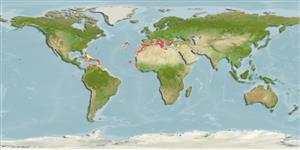Common names from other countries
Environment: milieu / climate zone / depth range / distribution range
экология
; пределы глубины 101 - 800 m (Ref. 80197). Subtropical; 45°N - 6°N, 78°W - 36°E
Atlantic Ocean and the Mediterranean Sea.
Length at first maturity / Size / Вес / Возраст
Maturity: Lm ? range ? - ? cm Max length : 1.6 cm CL самец/пол неопределен; (Ref. 80197); 1.86 cm CL (female)
Maximum depth from Ref. 106425. Maximum length is based on occurrence from Ref. 80197; to be replaced with a better reference. Found on the middle and upper slopes (Ref. 79118) in mud assemblage (Ref. 102666). Non-migratory macrozooplankton feeder (Ref. 52384). Preys on euphausiids, mysids, hyperiids, insect remains, mesopelagic fish and planktonic forams (Ref. 102666).
Life cycle and mating behavior
половая зрелость | размножение | нерест | икра | Fecundity | личинки
Members of the order Decapoda are mostly gonochoric. Mating behavior: Precopulatory courtship ritual is common (through olfactory and tactile cues); usually indirect sperm transfer.
Основная ссылка
ссылки | координатор | соавторы
Bisby, F.A., M.A. Ruggiero, K.L. Wilson, M. Cachuela-Palacio, S.W. Kimani, Y.R. Roskov, A. Soulier-Perkins and J. van Hertum. 2005. (Ref. 19)
Статус Красного Списка МСОП (Ref. 130435)
Статус СИТЕС (Ref. 108899)
Not Evaluated
Not Evaluated
Использование человеком
| FishSource |
инструменты
дополнительная информация
ресурсы в Интернет
Estimates based on models
Preferred temperature
(Ref.
115969): 13.2 - 15, mean 14.1 (based on 112 cells).
устойчивость к внешним воздействиям
высокий, минимальное время удвоения популяции до 15 месяцев (K=0.55-0.75).
